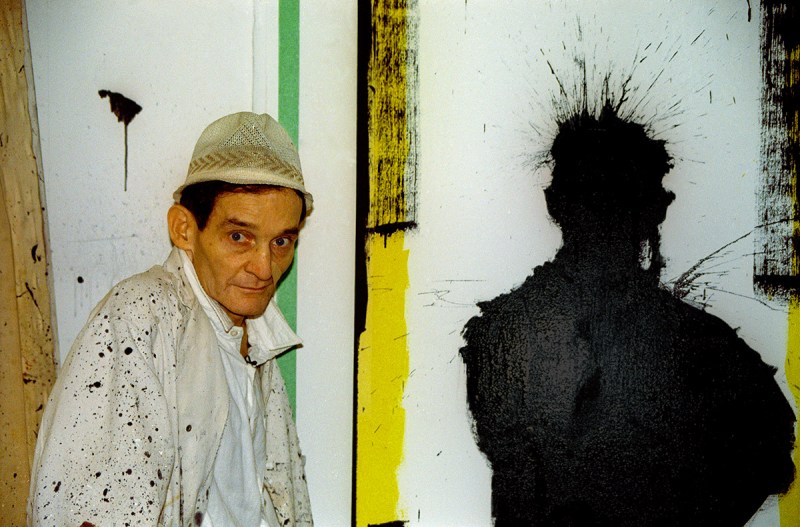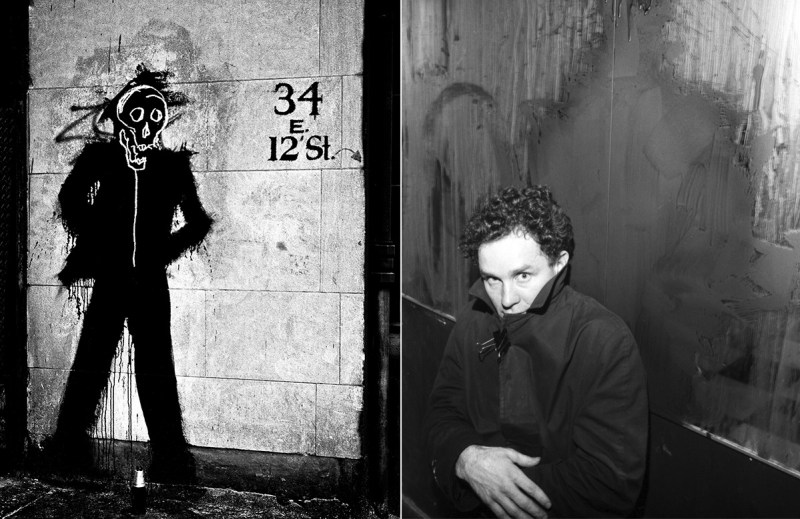
Long before Banksy tagged his first wall, another street artist was causing a similar commotion in the neighborhoods of Manhattan.
In the early ’80s, New York City was known for cheap rents, crime, and shady alleyways—literally and figuratively. Areas like the Lower East Side and Tribeca were dimly-lit and had few inhabitants, which made them ripe for the enterprising “Mr. Rhee.”
That was the artistic alias used by New York transplant Richard Hambleton, who created a “mass murder series” that caused a stir at the time—tracing over friends’ figures in the streets to make dead-body cutouts and then splashing them with red paint.
“People really began to think I was murdering people, going back to the hotel covered in red paint—blood-red paint,” Hambleton, who attracted local headlines for his art, says in the new documentary about his work, Shadowman, set to debut this week at the Tribeca Film Festival.
But don’t tell Hambleton his work was graffiti or vandalism.
“There’s a big difference from graffiti and what I do. My paintings may look fast and spontaneous, but there’s a lot of planning and premeditation that goes into it,” Hambleton says in the film. “I wanted to paint realism. I wanted to make the news. That was part of the work. Playing with the media.”

Shadowman chronicles the birth of urban street art in 1980s New York, a scene that includes pioneers like Hambleton, Jean-Michel Basquiat, and Keith Haring.
Those bold strokes led to a movement that has gone global, thanks to the rise of the internet and a high-end gallery market for the next generation of artists’ work.
“Banksy’s confidant told me that Banksy regarded Richard’s work as the beginning of street art,” Shadowman director Oren Jacoby told RealClearLife. “Banksy came to New York because of Richard.”
After the murder series, Hambleton’s calling card became his “Shadowman” series—life-size images of the artist painted on walls and buildings in dark locations. As the paint faded, all that was left was a black shadow.
“The first time that you saw them you thought they were real. You thought a real person was there,” said Jacoby, a native New Yorker, who first encountered the figures in his own neighborhood during that era. “Then you see them again and you realize it’s art. You engaged with it in a very special way.”

Nearly 30 years later, Jacoby met Hambleton and was inspired to make Shadowman. The documentary follows Hambleton’s rise in the art world, followed by an escape that took him to Europe for several years and subsequent fall that led to drug use and homelessness.
Yet unlike Basquiat and Haring, Hambleton didn’t die—and neither did demand for his work. Over the years, several investors have tried to revive his career. At one point, after being evicted from his Chinatown studio, an investor offered Hambleton free residence at the Trump SoHo Hotel in exchange for one painting a week. Unfortunately, the deal only lasted six months after Hambleton trashed his hotel room during a bender.
“At least Basquiat died. I was alive when I died. That’s the problem,” Hambleton says in the doc.
While Basquiat and Haring both enjoyed monetary success during their lives, Jacoby said Hambleton wasn’t career-minded. He may have been a talented artist, but he was a lousy self-promoter and businessman.
“Richard never gave away his best pieces,” Jacoby said. “By nature of his character he never made more paintings than he needed. It was hard to get his work.”
Still, Jacoby said it’s Hambleton’s extraordinary tenacity that makes him so fascinating.
“He keeps painting—whatever horrible obstacles he has,” Jacoby said. “Right now he’s battling skin cancer, but he doesn’t stop painting and producing art.”
It’s only appropriate then that the film is premiering at the Tribeca Film Festival, the original stomping ground for Hambleton’s work. Shadowman doubles as a love story to New York City.
“Richard is a main character, but New York is the other main character,” Jacoby said. “New York was a scary place in the ’80s. But it was also a place for opportunity for young artists. I was lucky to be on the fringe of that.”
The film opens April 21 in Manhattan. See the full release schedule here.
—Kellie Ell for RealClearLife
This article was featured in the InsideHook newsletter. Sign up now.























